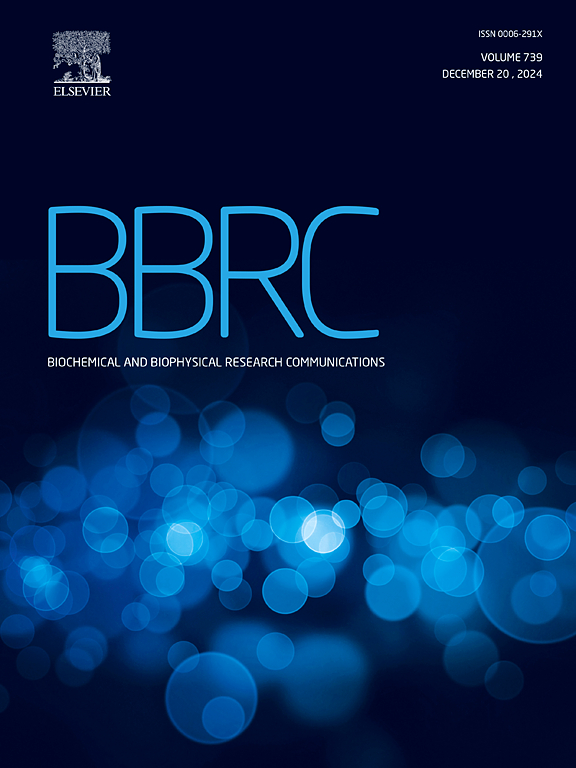Sine Oculis Homeobox同源物2在结肠癌中的作用:对预后、免疫调节和治疗意义的见解
IF 2.5
3区 生物学
Q3 BIOCHEMISTRY & MOLECULAR BIOLOGY
Biochemical and biophysical research communications
Pub Date : 2025-05-21
DOI:10.1016/j.bbrc.2025.152038
引用次数: 0
摘要
结肠癌(CC)仍然是一个重要的全球健康负担,寻找新的预后生物标志物和治疗靶点至关重要。本研究全面分析了SIX2 (Sine Oculis Homeobox Homolog 2)在CC中的作用,利用TCGA、GTEx和CCLE数据库的数据,发现SIX2在多种肿瘤中的差异表达,在许多肿瘤中与正常组织相比显著上调。在CC中,SIX2的差异表达是显著的。Cox回归分析显示其预后意义,过表达与不良生存结果相关。SIX2与基因改变密切相关,并与WNT、TGF-β等关键信号通路相关。在肿瘤微环境中,SIX2与免疫细胞浸润和免疫相关分子有关。值得注意的是,在CC中,它与免疫抑制细胞和检查点分子有关。此外,ABT737被发现在SIX2的背景下对肿瘤免疫治疗增敏。动物实验表明,ABT737能有效抑制小鼠CC的生长,且与抗pd -1免疫治疗联合使用效果更好。它可以减少CD163+肿瘤相关巨噬细胞的浸润,但不能显著增加CD8+ T细胞的浸润。我们的研究结果表明,SIX2是CC的潜在关键参与者,为未来的研究和靶向治疗的发展提供了见解。本文章由计算机程序翻译,如有差异,请以英文原文为准。
The role of Sine Oculis Homeobox Homolog 2 in colon Cancer: Insights into prognosis, immune regulation, and therapeutic implications
Colon cancer (CC) remains a significant global health burden, and the search for novel prognostic biomarkers and therapeutic targets is crucial. This study comprehensively analyzed the role of SIX2 (Sine Oculis Homeobox Homolog 2) in CC. Utilizing data from TCGA, GTEx, and CCLE databases, differential expression of SIX2 was observed in multiple cancers, with significant upregulation in many tumors compared to normal tissues. In CC, SIX2's differential expression was notable. Cox regression analysis revealed its prognostic significance, with overexpression associated with poor survival outcomes. SIX2 was strongly associated with gene alterations and correlated with key signaling pathways like WNT and TGF-β. In the tumor microenvironment, SIX2 was related to immune cell infiltration and immune-related molecules. Notably, in CC, it was associated with immunosuppressive cells and checkpoint molecules. Additionally, ABT737 was found to sensitize tumor immunotherapy in the context of SIX2. Animal experiments demonstrated that ABT737 effectively restricted the growth of CC in mice, and its combination with antiPD-1 immunotherapy was more effective. It could reduce the infiltration of CD163+ tumor-associated macrophages but without significantly increasing the infiltration of CD8+ T cells. Our findings suggest that SIX2 is a potential key player in CC, offering insights into future research and the development of targeted therapies.
求助全文
通过发布文献求助,成功后即可免费获取论文全文。
去求助
来源期刊
CiteScore
6.10
自引率
0.00%
发文量
1400
审稿时长
14 days
期刊介绍:
Biochemical and Biophysical Research Communications is the premier international journal devoted to the very rapid dissemination of timely and significant experimental results in diverse fields of biological research. The development of the "Breakthroughs and Views" section brings the minireview format to the journal, and issues often contain collections of special interest manuscripts. BBRC is published weekly (52 issues/year).Research Areas now include: Biochemistry; biophysics; cell biology; developmental biology; immunology
; molecular biology; neurobiology; plant biology and proteomics

 求助内容:
求助内容: 应助结果提醒方式:
应助结果提醒方式:


